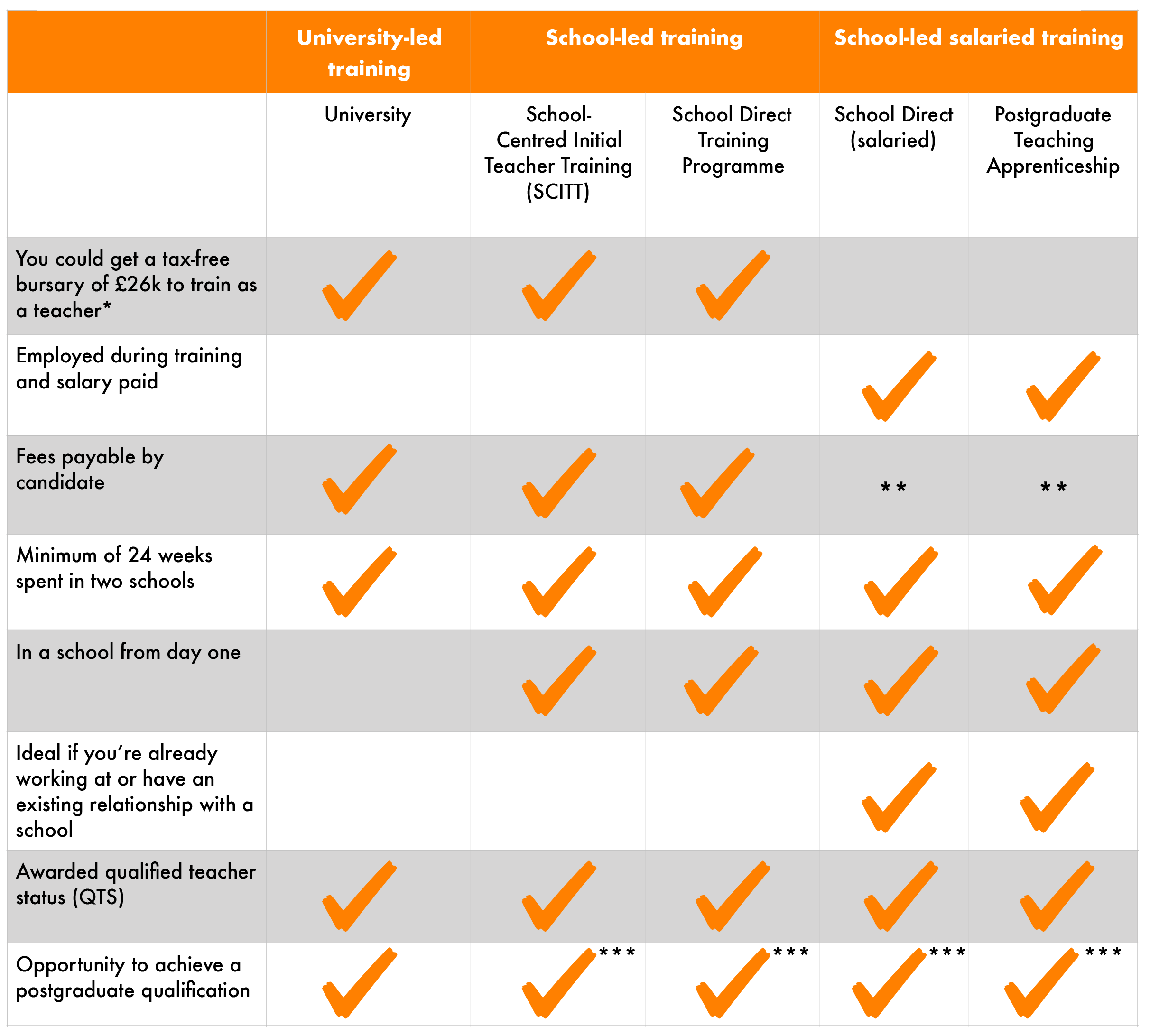DfE TEACHER TRAINING
Use this service to apply for a postgraduate teacher training course to teach in a state primary or secondary school, or in further education. Access here.

SCITT
Across England there are school-led training options for graduates who want hands-on training in a school.
On a school-led training course, you’ll get the chance to learn on the job in at least two schools, learning from experienced colleagues and putting your new skills into practice from day one.
When it comes to choosing a school, it’s worth bearing in mind its location so you can plan accordingly.

SCHOOL DIRECT
School Direct courses are based on the skills providers are looking for in a Early Career Teacher (ECT).
Designed by groups of schools in partnership with a university or a school-centred initial teacher training (SCITT) provider, the schools recruit you as a trainee with a job in mind just for you.
This is a popular choice for those who hope to secure a role in the network of schools where they train. School Direct courses generally last a year and result in Qualified Teacher Status (QTS) – most also award you a Postgraduate Certificate In Education (PGCE) and/or Master’s-level credits.
You’ll train in at least two good schools, getting the chance to learn ‘on the job’ – but you shouldn’t worry about being thrown in at the deep end. You’ll be part of a team from the very start, receiving intensive support from experienced teachers and mentors. That means you won’t be teaching classes unsupported until the school thinks you’re ready.

UNIVERSITY
If you are a graduate, you may want to train via a university-led course at a university or college.
University-led courses run full-time over one year, or part-time over two years.
Your training will include spending time at your university or college, working with other trainees and being taught by university colleagues.
You’ll also spend plenty of time in your placement schools – a minimum of 24 weeks.
This will help you develop your practical teaching skills and ability to manage and plan classes effectively.
All courses lead to Qualified Teacher Status (QTS) and a Postgraduate Certificate in education (PGCE).
CHOOSING THE RIGHT PROVIDER
Find A Route That Suits You
There are many things you need to consider when deciding which schools and/or universities you want to apply to train with.
Search for teacher training courses
You can use this link to find courses by location or by training provider. It allows you to view available teacher training courses and to filter results by: location, age range, subject, type of vacancy, specific training provider names, programme type and outcomes (what qualification the course includes).
Use your School experience
Gaining school experience will help you gain a better understanding of the different options that are available, and the teachers you meet may be able to tell you about other training providers in your area.
Location & Costs
To help fund your training, you could get a £26,000 bursary. for secondary education. With or without a bursary, there are tuition fee and maintenance loans available to help you cover your fees and living costs if you’re on a non-salaried course. You can use the student finance calculator to estimate student loans and extra funding that may be available. If you’re on a salaried course, you can estimate any in-work benefits by using the calculators on GOV.UK.
Do your research
Once you have an idea of the courses available, you can start researching individual providers in more detail via their websites or by attending a teacher training event.
To help you make a more informed decision of the type of course that’s right for you, you may find it useful to see how newly qualified teachers rated the different types of teacher training in the 2018 NQT annual survey.
Other things to consider
Remember, if you need to commute or relocate to be able to undertake your training, it’s important to consider the logistical and financial implications. For example: the cost of public transport and length of commute; would you know where your chosen providers’ placement schools are?
What are your accommodation options if you need to relocate, and are they within your budget?
WHICH COURSE IS RIGHT FOR YOU
There are many things you need to consider when deciding which providers and/or universities you want to apply to train with. Use the table below to find out what each postgraduate teacher training route has to offer.


